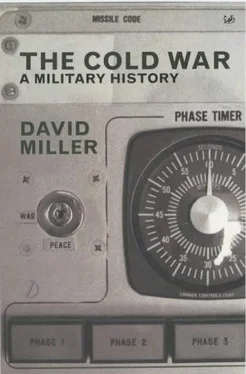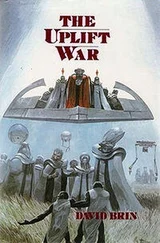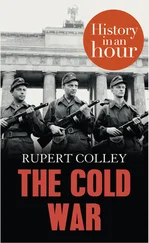As if all this was not enough, Asia was in turmoil. The Chinese Civil War was at its height in the late 1940s, with the Communists appearing certain to win. In addition, a number of western European powers found themselves involved in colonial wars. The French war against the Viet Minh in Indo-China broke out in 1947, while the British war in Malaya (a so-called ‘emergency’) started in 1948; in both cases the enemy were Communists. In divided Korea, the Communists in the North were beginning to menace the non-Communist South. Everything seemed to confirm the widespread perception of a Communist drive for world power.
It is, therefore, scarcely surprising that in such an atmosphere Western leaders began to look to their defences – something which, with the elimination of the German threat, many had hoped to place into a state of benevolent neglect for at least a decade.
The capitals of western Europe were pervaded by a sense of impending crisis as the blows came thick and fast, and, in the face of what appeared to be an imminent catastrophe, they struggled to find some means of regional co-operation and common defence. Their initial and somewhat hesitant attempts had varied degrees of success, but all eventually came together in a major success – the North Atlantic Treaty.
The first major post-war treaty in western Europe was the Anglo-French Treaty of Dunkirk, which was signed on 4 March 1947. On the surface this was a fifty-year mutual-defence treaty against future German aggression, although both countries understood that it was really aimed against the Soviet Union. As the Soviet activities in eastern Europe continued to cause alarm, however, the British foreign secretary, Ernest Bevin, suggested that there should be a network of similar bilateral treaties between like-minded countries, but he soon changed his views and began to advocate widening the scope of the Dunkirk Treaty to include the Benelux countries.
Benelux was one of the first groupings to be formed after the Second World War and consisted of Belgium, the Netherlands and Luxembourg, all of which had previously tried neutrality in one form or another. Belgium had been neutral since its creation in 1839, but was overrun in both 1914 and 1940 because it had the misfortune to sit on the planned German routes into France. The Netherlands had also long been neutral, and managed to remain so in the First World War, but, like the rest of continental Europe, was occupied by the Germans in the Second World War. Unlike the other two, Luxembourg’s neutrality was not voluntary but had been imposed by the Treaty of London (1867), although the country’s small size and virtually disarmed status meant that the treaty proved to be totally ineffective in both world wars.
The idea of co-operation between the three countries had been mooted during the war and led, in due course, to a customs union in 1948. The countries had, however, already agreed to co-operate in foreign-policy matters, and this led to a conference in Luxembourg in January 1948 at which they agreed on a common defence policy, in which the idea of a network of bilateral agreements would be rejected in favour of multilateral regional agreements. Thus, when invited by France and the UK to join the Dunkirk Treaty, they adopted a common line that it was pointless having a treaty unless it was designed for protection against the Soviet Union, and to be effective such a treaty, they suggested, must include the USA – although this was not achieved in the short term.
Negotiations began in January 1948, and such was the pressure of events (particularly the Communist coup in Czechoslovakia) that a draft was circulated on 19 February and the new Brussels Treaty (also known as the Western Union) was initialled on 13 March and signed on 17 March 1948.
This treaty, in which the Five Powers (Belgium, France, Luxembourg, the Netherlands and the UK) agreed to collaborate in defence as well as in the political, economic and cultural fields, was unique in several ways. First, although there had been many previous peacetime alliances, this was the first to establish a permanent political and military organization in western Europe in peacetime. Second, it was formed to counter aggression in general and, unlike the Dunkirk Treaty, was ostensibly not directed against a specific threat, although there was little doubt, either then or later, that it was actually aimed at the Soviet Union. Third, it introduced a series of permanent bodies, rather than leaving the planning to sporadic liaison meetings between the relevant national military staffs. [2] The official description of the defence organization is given in Appendix 1 .
The negotiations leading to the signature of the Brussels Treaty did briefly consider the question of the Nordic countries, but they were quickly excluded, primarily because the five signatories considered themselves unable to offer a realistic guarantee of military protection to Scandinavia. This view was the result of contemporary military assessments coupled with a perceptible lack of enthusiasm for such a task among the Continental parties to the treaty, although for France and the UK memories of their disastrous attempt to help Norway in 1940 also played a part.
The aim of the defence organization was to provide for military and logistic co-ordination between the Five Powers and for the study of the tactical problems of the defence of western Europe. In addition, it was intended to provide the framework on which a command organization could be based in time of crisis or war. At the top of the organization was the Defence Committee, which in peacetime was composed of the defence ministers of the Five Powers; this was served by the Chiefs-of-Staff Committee and the Military Supply Board, both of which met regularly, usually in London.
The Chiefs-of-Staff Committee was responsible for advising the Defence Committee on all matters affecting the defence of western Europe, although it was also required to take into account members’ commitments in other parts of the world – a not insignificant requirement when, with the exception of Luxembourg, four members still had large overseas possessions. Within this broad directive the committee’s special tasks were to ensure that:
• the military resources of the five member countries were organized to meet the strategic requirements of the alliance;
• the forces of the various nations were welded into an effective fighting machine;
• the combined military resources of the five nations were allotted in the best way;
• a proper balance was maintained between the conflicting requirements of the European battle, on one hand, and internal security and home defence, on the other;
• the necessary resources were assessed, prepared and distributed, in particular to the commander of the European battle, whose special task would be to make the necessary operational plans and to put them into operation.
The Chiefs-of-Staff Committee was formed on 30 April 1948 and immediately set to work. In a significant move, the United States was invited to send military observers to London to help the committee with its work, particularly on plans and the thorny problem of supplies. As a result, a US delegation arrived in London in June, headed by Major-General Lyman L. Lemnitzer (who was later to be a NATO Supreme Allied Commander Europe).
Meanwhile, the Chiefs-of-Staff Committee was hard at work, and produced its first report in the astonishingly short time of two weeks. One of its fundamental conclusions was that, in the event of war with the USSR, the Five Powers should fight as far east in Germany as possible, in order not only to protect their own territories but also to create time for the USA to intervene.
Читать дальше












